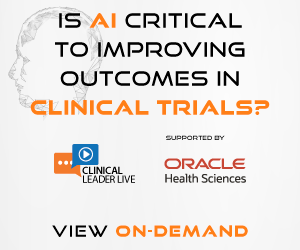New Report Focuses On Clinical Trial Disruption And The Impact On IRT

By Ed Miseta, Chief Editor, Clinical Leader

New advances in technology, along with the COVID-19 pandemic, are contributing to the ongoing disruption in the clinical trial space. Other factors playing into the disruption are emerging biopharma companies, decreasing ROI, and shifts in R&D focus. A new research report from Almac Clinical Technologies finds the disruption has resulted in demand for significant changes in IRT (interactive response technology) systems.
One of the more significant trends in drug development is the explosion in pipeline development. The days of the blockbuster drug may be over, but that has not slowed the development of new treatments. Over the last ten years, the number of new molecules in development has increased exponentially. According to the Pharma R&D Annual Review 2020, pharma pipelines have grown nearly 10 percent this year alone, and stands just shy of 18,000 drugs. That is almost double the number of molecules in development just 10 years ago.
Much of that growth is being driven by the increasing number of smaller biopharma companies entering the space. The IQVIA Pipeline Intelligence Report from January 2019 noted there were 3,212 active emerging biopharma companies. Emerging biopharma companies are defined as those having less than $200 million in estimated annual spending on R&D or under
$500 million in global revenue. The Almac Clinical Technologies report notes these smaller companies are also making significant contributions to the R&D pipeline. They are currently developing more than 90 percent of next-gen therapies and represent 73 percent of late stage research. In 2018 alone, these companies ran 65 percent of clinical trials. While the top 25 large pharma companies account for 1,845 pipeline products, the emerging biopharma companies account for 8,572. Large pharma companies no longer dominate the landscape.
R&D And ROI
R&D and ROI are also undergoing change. R&D programs are now increasingly focused on smaller more niche therapy areas with high levels of unmet need. According to Pharmaprojects from January 2020, the number of rare diseases under investigation grew from 389 in 2013 to 608 in 2019, an increase of 36 percent. There was also a sustained increase in the number of treatments granted orphan drug status.
While this development news is good, the cost of clinical trials remains a concern. Despite the pipeline growth, returns on pipeline development for sponsor companies is diminishing. This is due to the increasing costs of drug development. According to estimates from Deloitte, the cost of bringing an asset to market in 2019 was 67 percent higher than in 2010. Additionally, since 2010, sales per asset have been cut in half.
Despite the ROI challenges, new technologies are having a beneficial impact on trials. Technologies have enabled trials to be conducted faster and become more decentralized. Part of this is due to the impact of COVID-19. Lock down orders prevented many trial patients from traveling to clinical sites for routine visits. Other sites were overwhelmed with COVID-19 patients. This situation forced many pharma companies to re-evaluate their trial models and consider decentralized or partially decentralized models.
In those models, data collection was fully or partially shifted from clinical sites to patient’s homes. That shift, coupled with the move to risk-based monitoring, required the addition of new technology solutions.
Permanent Changes
As companies implement new technology solutions, there is growing hope that these changes to trial models will be permanent. A study conducted by Beroe found the use of technologies in the R&D space is growing at an annual rate of 22 percent to 23 percent. That growth rate is expected to continue through at least 2023.
Technology adoption is a positive trend, but it also means sponsor companies need to engage with more suppliers. More time must be spent on administrative and project management oversight. To help with this oversight, technologies need to support a simplified sourcing and on-boarding process. The Almac Clinical Technologies report notes one area that has been ripe for streamlining is patient randomization and trial supply management (RTSM/IRT) technology.
To determine the key pain points for IRT systems and sponsor preferences for future offerings, Almac Clinical Technologies conducted a survey of sponsor company executives in May 2020. Four pain points were identified.
- Lengthy IRT Build Times.
With increased speed to market being a concern, Lag times need to be reduced. Sponsors want a system that can go live quickly.
- Unplanned Protocol Changes.
Older legacy systems can make it challenging to respond to protocol changes in a timely and cost-efficient manner. Sponsors indicted a desire for a flexible system that can be easily modified.
- Complex Systems.
A complex system can impede the ability to run trials faster, which can lead to lost opportunity cost. Sponsors prefer more simplified, streamlined systems.
- Faster Study Start-Ups.
Faster study start-up is needed to help differentiate drugs and get them to market faster. Sponsors prefer systems that have the ability to go live in less than six weeks.
Survey respondents also indicated a preference for systems with some level of customization. Fifty-three percent of respondents prefer a fully customizable system while another 30 percent prefer a system that offers limited customization. The desire for a fully customizable system was greatest (59 percent) in the emerging biopharma companies.
When asked about features that would be most compelling to them, flexibility, price, and timelines ranked the highest. Price was the most important factor to emerging companies while timelines were the most important factor to large companies.
What Can Vendors Do Better?
Finally, the survey asked what IRT vendors could do to better meet the needs of sponsor companies. Although IRT plays a central role in study conduct, some systems have not modernized to respond to the evolving needs of sponsors. There were three key themes that emerged from the survey.
First, sponsors require better integration and flexibility. Trial design has undergone significant change, and sponsors need a flexible IRT system that can be easily adapted. Second, there needs to be shortened timelines to study start. With sponsors facing increasing pressure to decrease R&D costs, there is a heightened need for speed. The COVID-19 pandemic has accelerated that need.
Competitive pricing is also important. As the technology marketplace becomes more crowded and ROI on those investments continue to decline, sponsors will be pressured to be as efficient as possible with their R&D spending. That will result in many of them becoming more cost conscious.
The Almac Clinical Technologies State of the Industry Report: Embracing Trial Change and Elevating IRT Systems can be viewed here.

